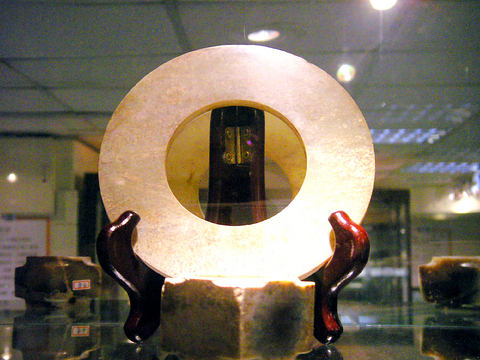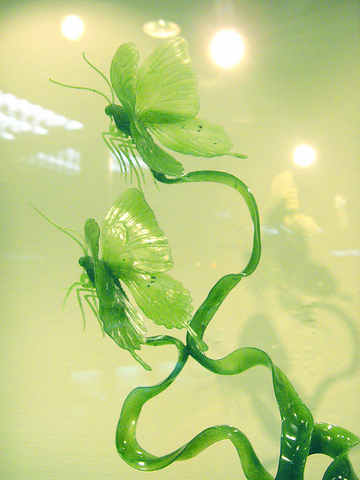Jade has long been a symbol of power in China. In the Neolithic Age, it was already being used to make ritual items. For long periods of history, the use of jade was the perquisite of imperial or royal families.
The Beauty of Jade and its Culture in East Asia Display (玉之華2 -- 東亞玉器與玉文化大展), showing until July 16 at the Sun Yat-sen Memorial Hall (國父紀念館), which claims to be the biggest exhibition of jade ever held in Taiwan, is an great opportunity to see jade through the ages. Comprising 2,500 pieces and spanning 7,500 years, the exhibition brings together items from over 100 private collectors. This is the second time this exhibition has been held, the first time being five years ago, also at the Sun Yat-sen Memorial. On that occasion, the exhibition attracted 100,000 people.
According to Tsai Sheng-hsiung (

PHOTO: GINGER YANG, TAIPEI TIMES
Among the collectors who contributed to the show is U Chu Pharmaceutical (
This is a piece of white jade with a color and texture described as being like lanolin cream (羊脂白玉). It's size alone makes it extremely rare, for large pieces of high quality jade are difficult to come by. Moreover, the characters on the stone are carved by the Qianlong emperor himself. There are many pieces of jade that originated from Qianlong's collection.
For sheer size, there is also a 40kg rock of jade. It is said to be worth over NT$20 million, but because of its size, the organizers are not unduly concerned that anyone will walk away with it.

PHOTO: GINGER YANG, TAIPEI TIMES
Because of the enormous value put on jade, many ways have been found to fake precious jade. There is a special section of the exhibition devoted to this.
"People burn it, oil it and tint it to make the jade look older and add to its value," said Chen Chung-chung (
While many of the Jade objects on display come from China, there are also a selection of jade pieces made by local artists.
There are six pieces in the show carved by Huang Fu-shou (黃福壽), a well-know jade carver from Hualien. He made a name for himself carving the locally quarried Fengtien jade (豐田玉), which is almost as hard as quartz. His works exhibit a delicacy totally in contrast to the extreme hardness of his material.

On April 26, The Lancet published a letter from two doctors at Taichung-based China Medical University Hospital (CMUH) warning that “Taiwan’s Health Care System is on the Brink of Collapse.” The authors said that “Years of policy inaction and mismanagement of resources have led to the National Health Insurance system operating under unsustainable conditions.” The pushback was immediate. Errors in the paper were quickly identified and publicized, to discredit the authors (the hospital apologized). CNA reported that CMUH said the letter described Taiwan in 2021 as having 62 nurses per 10,000 people, when the correct number was 78 nurses per 10,000

As we live longer, our risk of cognitive impairment is increasing. How can we delay the onset of symptoms? Do we have to give up every indulgence or can small changes make a difference? We asked neurologists for tips on how to keep our brains healthy for life. TAKE CARE OF YOUR HEALTH “All of the sensible things that apply to bodily health apply to brain health,” says Suzanne O’Sullivan, a consultant in neurology at the National Hospital for Neurology and Neurosurgery in London, and the author of The Age of Diagnosis. “When you’re 20, you can get away with absolute

When the South Vietnamese capital of Saigon fell to the North Vietnamese forces 50 years ago this week, it prompted a mass exodus of some 2 million people — hundreds of thousands fleeing perilously on small boats across open water to escape the communist regime. Many ultimately settled in Southern California’s Orange County in an area now known as “Little Saigon,” not far from Marine Corps Base Camp Pendleton, where the first refugees were airlifted upon reaching the US. The diaspora now also has significant populations in Virginia, Texas and Washington state, as well as in countries including France and Australia.

May 5 to May 11 What started out as friction between Taiwanese students at Taichung First High School and a Japanese head cook escalated dramatically over the first two weeks of May 1927. It began on April 30 when the cook’s wife knew that lotus starch used in that night’s dinner had rat feces in it, but failed to inform staff until the meal was already prepared. The students believed that her silence was intentional, and filed a complaint. The school’s Japanese administrators sided with the cook’s family, dismissing the students as troublemakers and clamping down on their freedoms — with